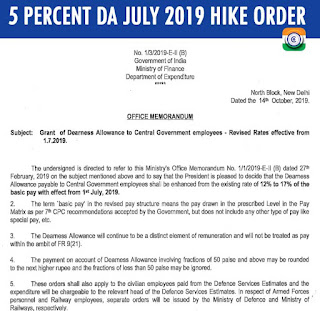On 7th Pay Commission implementation, private investment, Air India and more, here’s what govt is mulling over

Besides the government staff, economic analysts are keenly awaiting when and how the Centre will implement 7th Pay Commission award, which has implications for government finances (with estimated outgo of Rs 74,000 crore in FY16) as well as on inflation.
Also, with private investments yet to show decisive signs of picking up, the government has the difficult task of keeping the tempo in public spending, especially capital investments, at a time it is losing the benefits of low crude oil prices.
Finance secretary Ashok Lavasa speaks on these issues in an interview to FE’s Prasanta Sahu. Excerpts.
GDP growth in FY16 was put by the Central Statistics Office at 7.6%, with the growth in the last quarter coming in at 7.9%. Private consumption has been the growth driver. Despite the efforts by the government, private investors are yet to shed their diffidence. Among infrastructure sectors, highways, railways etc. have seen a turnaround but mainly because of government investment. How far is this model sustainable given the Centre’s (limited) fiscal capacity?
Many infrastructure projects, in which private sector has been involved, have started moving. In highway sector, for example, the hybrid annuity model has started attracting investors. As we go forward, we feel that the initiatives that have been taken by the government – to improve the ease of doing business and integrate various clearances – would give a push to private-sector investments. In infrastructure sectors, where the government plays a key role in awarding contracts etc, we are seeing positive results too. If all the factors are favourable, the GDP growth could be close to 8% this year.
The questions about GDP data refuse to wither away. Manufacturing GDP growth and the IIP (industrial production) data aren’t quite compatible, even if one considers the fact that apart from output, value addition is now being captured more efficiently.
The Q4 results of some of the major companies show that their EBITDA has increased. The variation between manufacturing growth (9.3% in FY16) and IIP (2.4%) was mainly due to the fact that some sectors did well while some did not.
How important are lower interest rates in reviving demand?
I think it’s a question of giving a boost to demand. Sometimes people may have more expectation than what RBI could do (in terms of lowering rates). The RBI has had to consider various factors and take a considered view. It is not possible to please all people all times. It is fair to expect that whatever lowering (of rates) has been done by RBI, finds an expression in the retail lending rates. I think the governor is right in saying full transmission has not happened of the central bank’s (cumulative 150 bps) rate cut since January 2015.
What will be the guiding framework of the “prospective planning” that will replace five-year Plan?
We could divide it into three parts: the period till which one can have some predictability on availability of resources, that will be, say, a three-year action plan. Beyond this, there will be medium-term (seven-year) Plan. Besides, there can be a prospective plan for theb period till 2030. In the prospective plan, what you already have is sustainable development goals, which are part of the international commitments. Niti Aayog will look at integration of issues and prospective planning while department of expenditure will make the fund allocations for various programmes.
Will substantial additional provision be needed to meet the Pay Panel-related outgo in FY17?
It will be too early and premature to say whether budgetary provision is not adequate or not. No one knows to what extent the government will accept the Pay Commission’s report. But, there is a provision in the budget to take care of the impact of the pay commission award (According to sources, FY17 budget has provision of about Rs 54,000 crore for honouring the pay panel’s award, but Lavasa refused to comment on this ).
Will Niti Aayog’s reported suggestions on strategic disinvestments in a clutch of PSUs including Air India be taken forward this year?
We haven’t so far received the recommendations you are referring to. We have to explore all forms of divestment and strategic sale is of course one of them. The Department of Investment and Public Asset Management will be looking at all possibilities and deciding on which unit to be put on privatisation or disinvestment or strategic sale mode.
Is there any move to monetise surplus land with defence, railways and ports bodies?
This is not to be done as a central government policy. The railways have been trying to monetise land. Certainly, this is one source of revenue, but it may be not a very significant source. Whenever an entity decides to take up any piece of land for monetisation, it has to consider all the legal issues, physical condition, its own plans of utilising and ultimately, if there is a market for that (in case of sale/leasing out).
Source: FE

Besides the government staff, economic analysts are keenly awaiting when and how the Centre will implement 7th Pay Commission award, which has implications for government finances (with estimated outgo of Rs 74,000 crore in FY16) as well as on inflation.
Also, with private investments yet to show decisive signs of picking up, the government has the difficult task of keeping the tempo in public spending, especially capital investments, at a time it is losing the benefits of low crude oil prices.
Finance secretary Ashok Lavasa speaks on these issues in an interview to FE’s Prasanta Sahu. Excerpts.
GDP growth in FY16 was put by the Central Statistics Office at 7.6%, with the growth in the last quarter coming in at 7.9%. Private consumption has been the growth driver. Despite the efforts by the government, private investors are yet to shed their diffidence. Among infrastructure sectors, highways, railways etc. have seen a turnaround but mainly because of government investment. How far is this model sustainable given the Centre’s (limited) fiscal capacity?
Many infrastructure projects, in which private sector has been involved, have started moving. In highway sector, for example, the hybrid annuity model has started attracting investors. As we go forward, we feel that the initiatives that have been taken by the government – to improve the ease of doing business and integrate various clearances – would give a push to private-sector investments. In infrastructure sectors, where the government plays a key role in awarding contracts etc, we are seeing positive results too. If all the factors are favourable, the GDP growth could be close to 8% this year.
The questions about GDP data refuse to wither away. Manufacturing GDP growth and the IIP (industrial production) data aren’t quite compatible, even if one considers the fact that apart from output, value addition is now being captured more efficiently.
The Q4 results of some of the major companies show that their EBITDA has increased. The variation between manufacturing growth (9.3% in FY16) and IIP (2.4%) was mainly due to the fact that some sectors did well while some did not.
How important are lower interest rates in reviving demand?
I think it’s a question of giving a boost to demand. Sometimes people may have more expectation than what RBI could do (in terms of lowering rates). The RBI has had to consider various factors and take a considered view. It is not possible to please all people all times. It is fair to expect that whatever lowering (of rates) has been done by RBI, finds an expression in the retail lending rates. I think the governor is right in saying full transmission has not happened of the central bank’s (cumulative 150 bps) rate cut since January 2015.
What will be the guiding framework of the “prospective planning” that will replace five-year Plan?
We could divide it into three parts: the period till which one can have some predictability on availability of resources, that will be, say, a three-year action plan. Beyond this, there will be medium-term (seven-year) Plan. Besides, there can be a prospective plan for theb period till 2030. In the prospective plan, what you already have is sustainable development goals, which are part of the international commitments. Niti Aayog will look at integration of issues and prospective planning while department of expenditure will make the fund allocations for various programmes.
Will substantial additional provision be needed to meet the Pay Panel-related outgo in FY17?
It will be too early and premature to say whether budgetary provision is not adequate or not. No one knows to what extent the government will accept the Pay Commission’s report. But, there is a provision in the budget to take care of the impact of the pay commission award (According to sources, FY17 budget has provision of about Rs 54,000 crore for honouring the pay panel’s award, but Lavasa refused to comment on this ).
Will Niti Aayog’s reported suggestions on strategic disinvestments in a clutch of PSUs including Air India be taken forward this year?
We haven’t so far received the recommendations you are referring to. We have to explore all forms of divestment and strategic sale is of course one of them. The Department of Investment and Public Asset Management will be looking at all possibilities and deciding on which unit to be put on privatisation or disinvestment or strategic sale mode.
Is there any move to monetise surplus land with defence, railways and ports bodies?
This is not to be done as a central government policy. The railways have been trying to monetise land. Certainly, this is one source of revenue, but it may be not a very significant source. Whenever an entity decides to take up any piece of land for monetisation, it has to consider all the legal issues, physical condition, its own plans of utilising and ultimately, if there is a market for that (in case of sale/leasing out).
Source: FE














0 comments:
Post a Comment